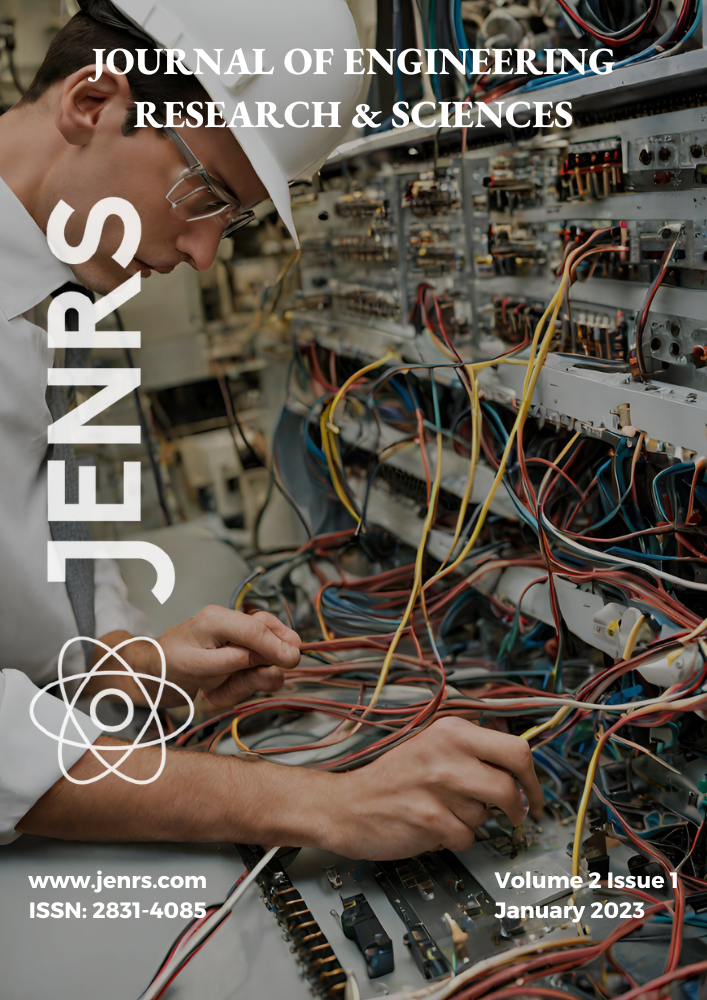
Volume 2, Issue 1
Download Complete Issue
This issue features three new research papers that break new ground in technology and engineering. The papers cover different areas: power systems, mobile app safety, and 5G networks. Each study offers new ideas and sets the stage for future work. The papers look at improving power plant control, making mobile apps more secure, and designing better parts for 5G devices.
Front Cover
Publication Month: January 2023, Page(s): i – i
Editorial Board
Publication Month: January 2023, Page(s): ii – ii
Editorial
Publication Month: January 2023, Page(s): iii – iv
Table of Contents
Publication Month: January 2023, Page(s): v – v
Modelling, Simulation and Sensitivity Analysis of Generator Control Systems using Coexisting and Cooperative Tools
Javier Urquizo, Diover Bonilla, Francisco Rivera, Rommel Chang
J. Engg. Res. & Sci. 2(1), 1-12 (2023);
This research is about tuning the automatic generator control (AGC) unit within the National Transmission System (NTG) and is intended to provide a set of key insights into problems related to generator control systems oscillations and the possible available solutions. The case study is the Baba Hydroelectric Power Plant in Ecuador. The aim is to model, simulate and validate the controls of the Baba generating units for an optimal and stable response. Both controllers, the Automatic Voltage Regulator (AVR) and Power System Stabilizer (PSS) were tuned using both a component-based approach using an object-orientated tool where the model structure resembles the original system, and a coexisting power flow tool in a signal orientated environment. A key part of this tuning is the adaptation of the model to different operating conditions by testing scenarios where signals ought to be defined before the start of the simulation and others be chosen for visualisation without any limitation, therefore, this paper is about finding a multi-framework environment. Also, the model was disturbed so to observe the field Voltage and terminal voltage values using a simplified and reduced part of the NTG. Results show that a high gain AVR helps the steady state and transient stabilities but may reduce the oscillatory stability and the PSS can provide significant stabilization of such oscillations. The validation strategy uses the average quadratic mean square error statistical method.
CAPEF: Context-Aware Policy Enforcement Framework for Android Applications
Saad Inshi, Mahdi Elarbi, Rasel Chowdhury, Hakima Ould-Slimane, Chamseddine Talhi
J. Engg. Res. & Sci. 2(1), 13-23 (2023);
The notion of Context-Awareness of mobile applications is drawing more attention, where many applications need to adapt to physical environments of users and devices, such as location, time, connectivity, resources, etc. While these adaptive features can facilitate better communication and help users to access their information anywhere at any time, this however bring risks caused by the potential loss, misuse, or leak of users’ confidential information. Therefore, a flexible policy-based access control system is needed to monitor critical functions executed by Android applications, especially, those requiring access to user’s sensitive and crucial information. This paper introduces CAPEF, which is a policy specification framework that enforces context-aware inter-app security policies to mitigate privacy leakage across different Android applications. It also, provides an instrumentation framework to effectively enforce different behaviors based on automated context-aware policies to each Android application individually without modifying the underlying platform. Accordingly, the modified applications will be forced to communicate with our centralized policy engine to avoid any malware collusion that occur without the users’ awareness. Experiments conducted on CAPEF shows an effective performance on the size of the enforced application after the instrumentation. The average size added was 705 bytes, which is about 0.063% of the size of the original applications, which is significantly small compared to other existing enforcement approaches. Also, we have denoted that the size and the execution time of the policy increases whenever the policies become more complex.
A Tunable Dual-mode SIW Cavity Based Bandpass Filter with Wide Upper Stopband Characteristics
Md. Atiqur Rahman, Pankaj Sarkar
J. Engg. Res. & Sci. 2(1), 24-29 (2023);
A new approach to design a bandpass filter using substrate integrated waveguide (SIW) topology is presented here for 5G applications. The aim of the design is to produce a dual mode passband characteristic with wide upper stopband behaviour, centred at 4.7 GHz. Four identical Stepped Impedance Resonator (SIR) slots are etched into the top surface of the SIW cavity for the proposed filter structure. The SIR slots aid in reducing the cavity’s resonant frequency and to generate the dual mode passband characteristics. The SIR slots also mitigate the higher modes in the SIW cavity which helps to accomplish a wide upper stopband response. In order to improve selectivity, the structure is further modified by introducing two E shaped resonator slots on the ground plane to produce two transmission zeros at 3.9 GHz and 6.2 GHz. Tunable characteristic is achieved by loading two surface mount varactor diodes diagonally on the top of the proposed structure. By suitably applying the bias voltage, the center frequency of the passband is tuned over a range of 600 MHz. The developed filter is fabricated in order to verify the simulated and measured results.

